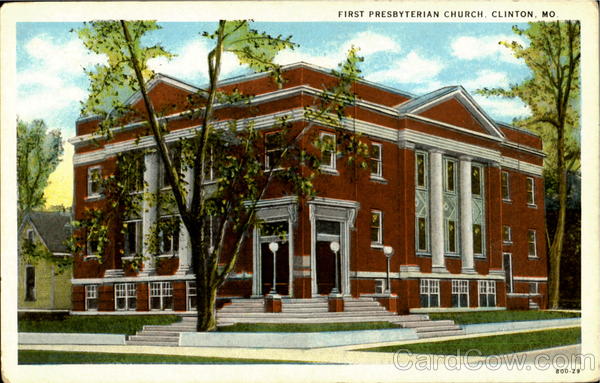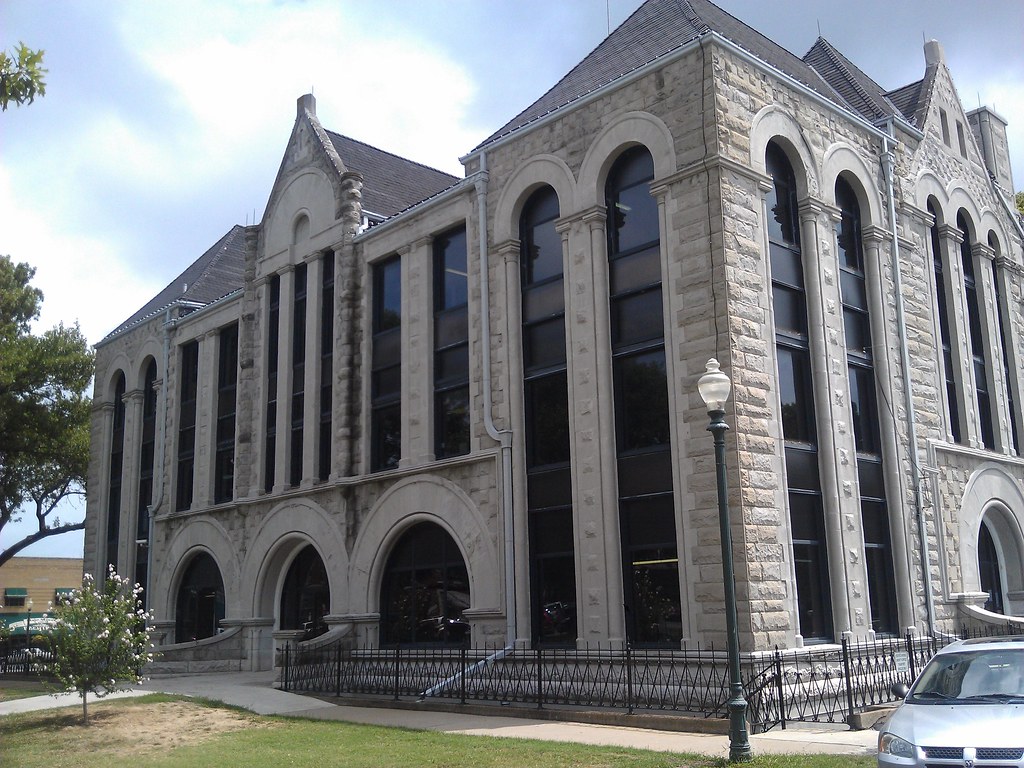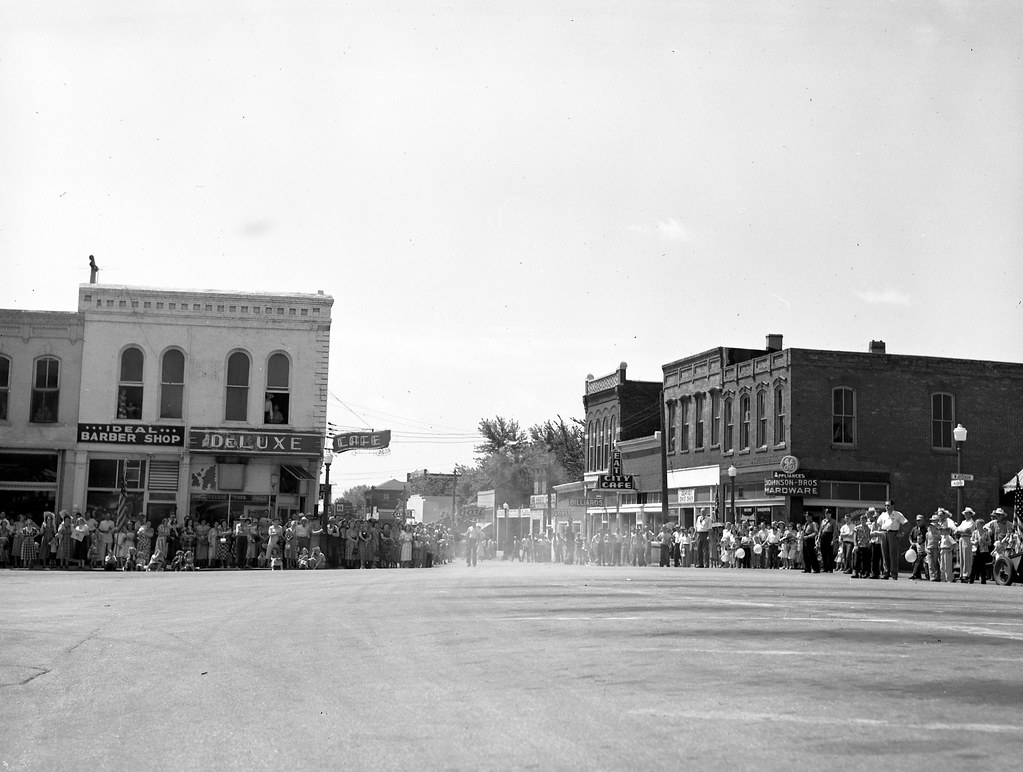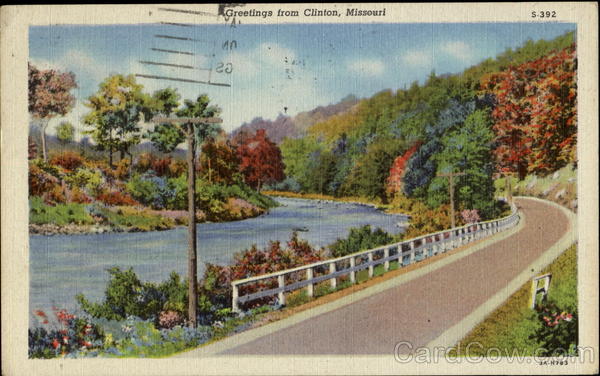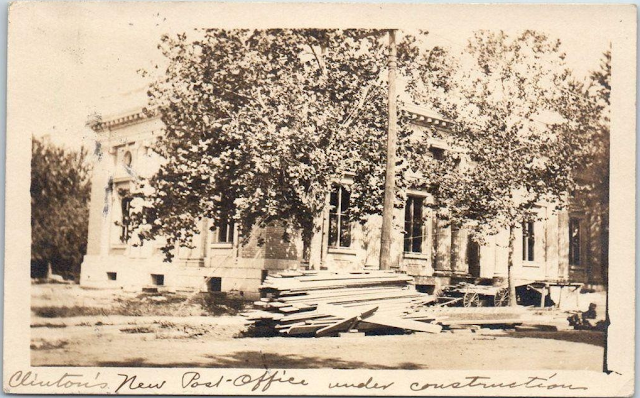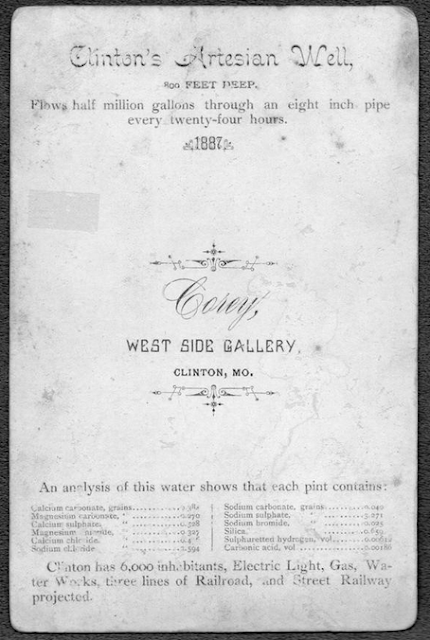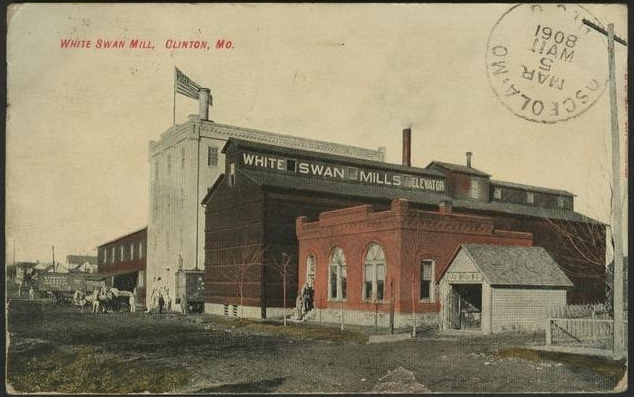Artesian Well, Clinton, MO
Established in 1887, in the era when spring water was associated with health, the Artesian Spring Well on the western edge of Clinton was a lively place. The Artesian Hotel catered to visiting spa enthusiasts. A race track was built and for several years the county fair was held here. Excursion trains, public buggies, carriages, and trolleys brought visitors to sample the curative, but malodorous, waters with their purgative effect on those who drank it. Besides the spring, which shot a fountain of water nearly 12 feet high, and lake, entertainments included a dance hall, county fairgrounds and horse racing.One and one-half miles southwest of Clinton, at the terminus of a horse-car line, are the beautiful grounds of the Artesian Park, containing a spacious lake, with hotel of three stories, basement, and attic, equipped with all modern conveniences, including dancing hall, billiard rooms and bowling alley, a pavilion, and boat and bath houses. The artesian well on the grounds discharges a palatable water, possessing known medicinal qualities, containing the chlorides of potassium, sodium, magnesium, and calcium,, the carbonates of magnesium and calcium,, sulphate of calcium, and sulhydric gas. The park is a favorite resort, and attracts visitors from considerable distances. The fountain spray subsided. Rumors circulated that a couple of local wags had dropped bowling balls into it, but more likely that the spring just lost pressure and thus its artesian effect. The original site comprised 40 acres. The bottomland area of the park became part of the Harry S. Truman Dam project. Today the site of the former artesian spring is overgrown. Elsewhere on the remaining grounds are playgrounds, tennis courts, and the Artesian Amphitheater, built in 2002 by Hilton Hotels Random Acts of Service.
 |
| Artesian Clinton, MO |
 |
| Artesian Well and Hotel, Clinton MO |
 |
| Artesian Park and Lake, Clinton MO |
Rainbow Motel, Clinton, MO
 |
| Little Girl, Clinton, MO |
Missouri’s first official state photographer, Gerald R. Massie, preserved the beauty and the history of the state through his photographs from 1945 to 1974. Born in Clinton, Mo., Massie’s interest in photography developed early in life at age 10 when he won his first camera, a $1.98 Brownie. While attending Clinton High School, he was employed as a printer’s devil at the Clinton Eye newspaper, learning Linotype operation.
Missouri's Gerald Massie
The State Photographer on the James River
By Carolyn Collings and Lynn Morrow
Gerald R. Massie (1911-1989) was Missouri’s first official state photographer, holding that position from 1945 to 1974. His interest in photography developed early in life as a youth in his native Clinton, Missouri, when, at the age often, he won a July Fourth bicycle race around the courthouse and as a prize, his first camera, a $1.98 Brownie. He worked as a printer’s devil on the Clinton Eye after high school eventually leaving town for work in the "big city." He carried a letter of recommendation from his former editor who wrote that he had a "good disposition that remains unruffled in times of hurry and need of speed." In 1936 he landed a night job for the Kansas City Star (Times) as a journeyman linotype operator, while doing freelance photography during the day.
Drafted in the Army in early 1942, he served during World War II with the U.S. Strategic Air Force as an aerial photographer, documenting the effects of bombing missions and taking ground news photos. In England he supervised a 22-man photo lab. During the war Massie earned a Bronze Star and five battle stars, surviving a returning bomber plan crash in England. In 1945 Massie returned to Missouri, and found a position as the state’s photographer in the newly formed Resources and Development Commission, later called Commerce and Industrial Development. One of his early assignments in 1946 was the coverage of Winston Churchill’s "Iron Curtain Speech" in Fulton, Mo. Massie quickly became a key figure in state government in 1946 when, for the first time in history, Missouri used state revenues to advertise the state nationally. In 1947, "The Great Pictures" contest co-sponsored by Encyclopedia Britannica and the University of Missouri School of Journalism, judged two of his photos among the nation’s 100 best (professor Clifton C. Edom was secretary of that competition and exhibition and editor of the book-length publication of the exhibit).
Assigned the task of promoting Missouri, Massie sent a steady stream of photographs to the Commission, and produced sixteen recreational booklets on Missouri regions, including The White River Country of Missouri and The White River Country of Missouri Map (Some 65,000 each of these two were circulated. Local historians recognize this famous series that included Mark Twain Region, Ozark Playgrounds, DanielBoone Region, Big Springs Country, Lake of the Ozarks, and more). He photographed Missouri’s natural and historic sites, parks, industry, commerce, and agriculture, specializing in many aerial photographs. To produce the Missouri regional series of booklets over a period of eight years, Massie traveled about 15,000 miles per year to take 1,500 photographs annually to arrive at some 300 quality prints. His most famous picture—"Missouri Dragon"—an aerial view from 10,400 feet of the Lake of the Ozarks, has been reproduced hundreds of times. Specialists in Missouriana will recall the caption, "Photo by Massie", seen on thousands of Missouri promotional publications.
Massie’s images appeared in national magazines and newspapers, as well as Missouri state publications, on television stations, in encyclopedias and school textbooks; publishers also printed them in foreign advertisements about Missouri, included reproductions on cake box tins, china plates, silver spoons, silk scarves, glass, postcards, and puzzles. Whenever possible, Massie implemented the old newspaper maxim, "A pretty girl has never yet hurt a picture." And to add to his interesting career, in 1956 he won a Mercury Monterey Phaeton from the Ed Sullivan Show.
Massie’s period of state service stretched across the governorships of Donnell, Donnelly, Smith, Dalton, Blair, Heames, and Bond. In his more than 28 years with the state, he served as acting director of his division three times, and at various times directed the Industrial, Tourism, Information and Museum sections. The recipient of many professional awards, he was appointed to the Missouri Academy of Squires in 1961 by Governor Blair for "his peerless photography of the Missouri scene over a long period of years." He valued correspondence from friends who appreciated his work, including "Fibber McGee and Molly" (Marian and Jim Jordan), Bob Cummings, Harry S Truman, and Thomas Hart Benton. Acquaintances all knew him for his white hair, a perpetual cigar, his news camera and his sales pitch that Missouri is the best state in the nation in which to spend a vacation or locate a business.
 |
| Gerald Massie Photograph |
In late 1991 Gerald Massie’s widow, Henrietta, donated 3,500 photographs and negatives to the Missouri State Archives where it joined the large Commerce and Industrial Development Collection, heavily influenced by Massie’ s work; another much smaller Massie collection resides at the State Historical Society of Missouri, Columbia. The images in this collection represent a major effort in the preservation of Missouri’s past. (Readers who wish to use the collection should consult with archivist Mark Herndon at the Missouri State Information Center, 314-751-7299.) With this brief introduction, the Quarterly presents samples of only one theme in the Massie Collection—the famous Missouri float-fishing trips down James River, hosted by industry leader Jim Owen.
Photojournalism Hall of Fame Gerald R. Massie link
 |
| Clinton, Missouri |
 |
| Dr. Samuel Jacob Neiberger. He was born in
Somerford Township, Madison County, Ohio and as a young man became a
physician. He married Lydia Ann Gilbert (1842-1910) in Pleasant, Clark
County, Ohio on December 10,, 1867. They were the parents of at least 3
children. By 1870 they were living in Clinton, Henry County, Missouri
and in 1880 they were in Delaware, Otoe County, Nebraska. In the 1890's
Dr. Neiberger had a medical practice in Burlington, Coffey County,
Kansas but by 1910 they had moved to Los Angeles, California. For a time
after his wife died in 1910, he lived in the US National Home for
Disabled Volunteer Soldiers in Sawtelle, California but then went to
live in Phoenix, Arizona where he died on October 6, 1921. He was buried
in Angelus Rosedale Cemetery in Los Angeles. The photo dates to the
1870's and was taken at the Calendar Studio in Springfield, Ohio. |

 |
| a 1890's-1900's, Original Photograph, of Horse Drawn Delivery Cart and Peddler, by Marks of Clinton, Missouri. |
 |
| ca 1890'S MR. TAYLOR ( Knight of Pythias) CABINET CARD PHOTO SKULL CROSS BONES WATCH FOB CLINTON, MISSOURI |
 |
| "July 26, 1911, #1." Embossed near the bottom
center is "Marks, Clinton, MO." This real photo postcard is used and
postmarked from Clinton, MO Aug 11, 1911, |
 |
| Lindstrom Hatchery, Clinton, MO |
 |
| Bush's Wonderlay Chicks, Clinton, Missouri |
Mrs. Vera Courtenay Thomas, Clinton, MO
Opera Star
1902 Courtenay Thomas, Clinton, Missouri
Metropolitan Opera Company
 |
| WEST SIDE of the Clinton, Henry County, Mo., Square about 1910. |
 |
| NORTH SIDE of the Clinton, Henry County, Mo., Square around 1910. |
SOUTH SIDE OF the Clinton, Henry County, Mo., Square around 1910. The area of the hand dug well which served our community for decades beginning in the late 1830s may be seen. It is the round object several feet from the courthouse lawn where, in 2017, the large granite fountain is situated. The well is now capped and under the pavement just a few feet from the present granite fountain. This now hidden well was a main source of water as the city well for Clinton from 1840 until other sources of water supply were developed. As such, this location in the 1840s and 1850s in addition to the 1860s was once the focus of a great deal of activity. It was from this well that hundreds, possibly thousands, of people each day drew water. Locals, people just passing through, settlers and military personnel. Clinton was on the frontier then. The War With Mexico had yet to be fought. To the west and southwest, in the 1840s, present day Kansas and Oklahoma, was Indian Territory. Further west, was the Empire of Mexico, including what is now New Mexico, a lucrative trading location for enterprising early day Missouri merchants who had caravans constantly traveling the Santa Fe Trail. John Dorman recalled in a story which appeared in The Clinton Daily Democrat some years after the Civil War, it was from this well Confederate Major General Sterling Price, commander of the Missouri State Guard, quenched his thirst on his march through Clinton with a number of divisions and thousands of Soldiers in 1861. It was, stated Dorman, a thrill to personally present General Price with a dipper of cold water. The old city well was covered over in 1877 as other sources of water were developed. Joe Pollock and Theodore Bolton purchased a Phoenix Stone to cover it. Years later, it was stated in this newspaper, the stone was moved so parking improvements could be made. At that time, the well was still filled with water. It may still be.

BARTH, David S.
White Oak Township
1919 History of Henry Co MO, Uel W. Lamkin, Historical Publishing Co pg 528
David Barth, a progressive young farmer and stockman of White Oak township, is a native of Henry County, and a descendant of pioneer parents. He was born in White Oak township on the place where he now resides, September 16, 1897, and is a son of John Barth, a Henry County pioneer. John Barth, now deceased, was an early settler in Henry County, and one of its successful citizens. He was a native of Germany and settled in White Oak Township, Henry County, in 1868. He bought some land here for six dollars per acre, and paid fourteen dollars for other land. He bought considerable land and at the time of his death was one of the largest land owners in the county. He gave to each of his fourteen children one hundred sixty acres of land, and besides his real estate holdings he was the owner of over thirty thousand dollars worth of personal property. John Barth's success in life was the result of industry, coupled with keen foresight and business ability. When he was a boy he worked for fourteen cents per day, and his early life's experience taught him the value of a dollar. He was one of the promoters of the town of Urich and contributed land for the railroad there. He was twice married. Five children were born to his first marriage and ten to his second. He died June 6, 1917, and his second wife, who bore the maiden name of Sophia Rombold, died May 26, 1911. Sophia Rombold was born July 3, 1858, at Logansport, Md., and was a daughter of David and Frances Rombold, natives of Wittenberg, Germany, who moved to Henry County in 1867. His first wife bore the maiden name of Lebold. David Barth, who resides on the old home place with his sisters, Josie and Tressie, owns one hundred eighty acres. He carries on a stock-raising extensively and keeps registered Herford cattle and big bone Poland China hogs, and is one of the extensive breeders of registered hogs in Henry County. He is also interested in the breeding of Shropshire sheep. David Barth was reared on the place which he now owns, and he takes an active interest in everything pertaining to modern agricultural methods. While he was reared a practical farmer, he also regards the science as one involving a broad field of experiment and research, and the future agricultural industry of this country becomes more and more dependent upon the type of men of whom David Barth is a representative.


